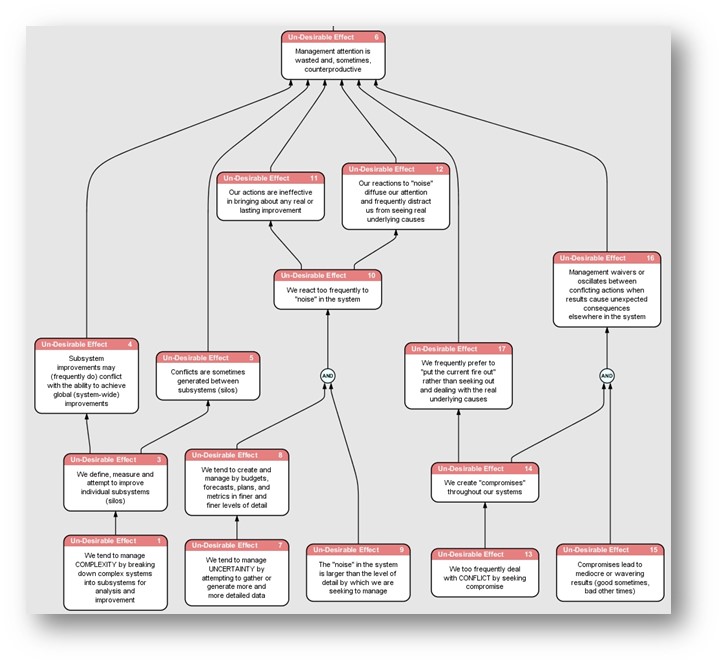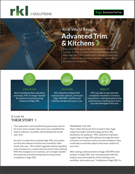Whether in your supply chain or within your own enterprise, the challenges that executives and managers must meet and defeat day after day can be grouped into three broad and generic classes:
- Complexity
- Uncertainty
- Conflict
Unfortunately, the typical ways in which managers respond to the challenges posed by these three classes leaves much to be desired

Complexity
When our minds are overwhelmed by complexities—like the many hundreds of moving part in our enterprises or our supply chains, and the tens of thousands of interactions between these moving parts that occur every day—we tend to respond by attempting to identify recognizable subsystems within the larger complexity.
If we can identify and rationally isolate subsystems, our hope is that we can define, measure and adjust or tune each subsystem. Our further hope is that our tinkering and tuning of the subsystems will lead to the optimized performance of the larger and more complex system of which it is merely a part.
Our belief that such a path of subsystem optimization will lead to the optimization of the whole is firmly ground in a mechanistic view of our enterprise (or, supply chain). That mechanistic view holds that each subsystem (e.g., department, function, or supplier) is merely a "cog" in the larger "engine" as a whole.
Unfortunately, supply chain and enterprise "systems" are not like machines, at all.
Instead of being mechanical in nature, they are, in fact, complex adaptive systems (CAS).
Complex adaptive systems do not behave like machines. It is not so easy to adjust this and expect a specific outcome in that. Complex adaptive systems, unlike machines, are characterized by the ability to internalize information, learn, and modify their behaviors and actions as they adapt to what is changing in their environment.
Put in more specific terms, it means that department B has already learned what to expect from department A in your organization (your "system")—including both the standard things the department does, and the quirky things that the department occasionally throws at it. From its learning, it has also adapted itself to those expectations.
If, therefore, you make department A change its behaviors, department B must re-learn and adapt itself to these changes in behavior. Furthermore, the improvement in department A (as you perceive it) may not have the desired effect on the overall system because, even if department B adapts to the change, some change in department C, D or F might effectively null out any "improvement" anticipated from the "improvement" made in department A.
For this reason, as shown in the accompanying Current Reality Tree (CRT), attempts to define, measure and improve subsystems in the absence of a full understanding of the entire system is likely to lead to policies, procedures and changes that actually conflict with the ability of entire system to achieve improvement. Sometimes, changes in one subsystem (read: department, or a vendor in a supply chain scenario) actually creates immediate and direct conflicts in a connected subsystem.
Uncertainty
The next big class of challenges faced by executives and managers is uncertainty.
Actually, we deal with uncertainty in a way very similar to the way we deal with complexity. We believe that the way to deal with too much uncertainty is to break it down into increasing levels of detail in hopes of unraveling the mystery that creates the uncertainty in our minds.
For example, if a forecast sales number seems too large (or, too small), an executive is likely to say something like, "Can you give the details behind this number?" As a result, one big number that is seems uncertain, might become 100, or 1,000, numbers. But, because each individual number is smaller, instead of having this gnawing feeling that the original number was off by $100,000, we can now tinker with the much smaller individual numbers—each one being adjusted by $100 here, or a $1,000 there. In the end, we may have only adjusted the larger number by $20,000 or so (20 percent), but somehow we feel more comfortable.
This action, in turn, tends to lead to creating and managing budgets, forecasts and plans in much finer level of detail. Management's metrics are frequently tied to the detail—if for no other reason than we have the computing power in their hands to do so.
Unfortunately, the smaller numbers and finer detail are all too frequently not large enough to absorb the "noise" level in the system.
Management finds itself swimming in a plethora of data where the actionable data may be nearly impossible to filter out of the noise. Instead of focusing on a single large issue that may be affecting the entire system at a deeper and more profound level, executives and managers get caught up in the minutia, reacting "noise," instead of real underlying cause-and-effect. Read my blog series Managing Complexity and Uncertainty.
Conflict
Conflict is the next class of challenges with which managers and executives must deal.
Since conflict avoidance is a rather natural human behavior, managers frequently prefer to merely put out the current fire and restore some semblance of normality, rather than dig into the real core causes of such fires.
How are such issues "put to sleep" again and again (as one of my former mentors used to say)?
All too often it is done through compromise.
Compromise is generally a matter of accepting either the best of the worst or the worst of the best. It is certainly no recipe for anything much beyond mediocrity, but the immediate payoff is that "the fire gets put out."
However, when root-causes are not addressed, a "fire" suppressed through compromise in one part of the organization, may break out as a different kind of "fire" in some other part of the system. Then, not infrequently, the original compromise action is reversed in favor of a different compromise to quell the current outbreak of fires.
It is not at all unusual to see managers and executives oscillating on an array of conflicts including:
- "Run larger batches for more efficiency and lower costs" versus "Break those setups now so we can get these other shipments out the door—it's quarter-end, you know!"
- "Buy those items in bulk to keep our unit-costs down" versus "We have too much inventory! Why do we have 100,000 of those widgets? We only use about 1,500 a month!"
- "We need to keep our margins up; no deep discounts" versus "It's year-end and we need those revenues now! Cut prices or do whatever you have to do to close those big deals before the 31st."
- "We need to keep our shipping costs down! No more shipping partial orders without management approval" versus "Look! Our customers are complaining and canceling their orders! Ship those partial orders today before they get cancelled, too!"
- "Our production payroll is through the roof! No more overtime!" versus "I don't care whose labor budget we bust! Get those items produced and shipped by the end of Q2 or heads will roll!"
Dealing effectively
By applying the principles first articulated so cogently by Eliyahu Goldratt it is possible to deal effectively with complexity, uncertainty and conflict. Doing so requires finding a way—and applying proper tools—to see your enterprise or your supply chain as a complex adaptive system and not as a machine.
We help companies do this using the Thinking Processes. The diagram above is actually one of the Thinking Process tools—a Current Reality Tree or CRT.
These tools and our training help companies begin to see how their organization—their system—behaves, learns and adapts. The system's behavior can be modeled in the Thinking Processes toolset.
Learning to use these tools, and being coached while you get started, can help put you and your team on the fast-track to a POOGI—a process of ongoing improvement.
[feature_box style="2" only_advanced="There are no title options for the choosen style" alignment="center"]
Read RKL eSolutions customer success stories and how a properly implemented business management solution can solve a variety of problems.
[/feature_box]




